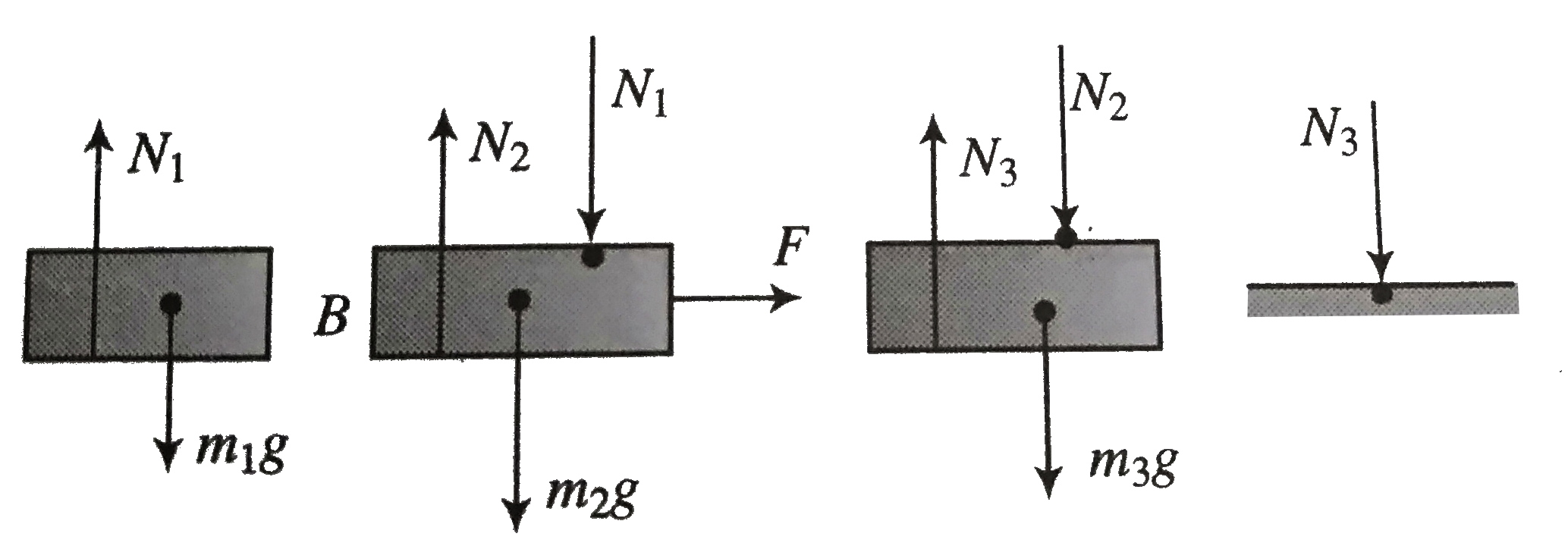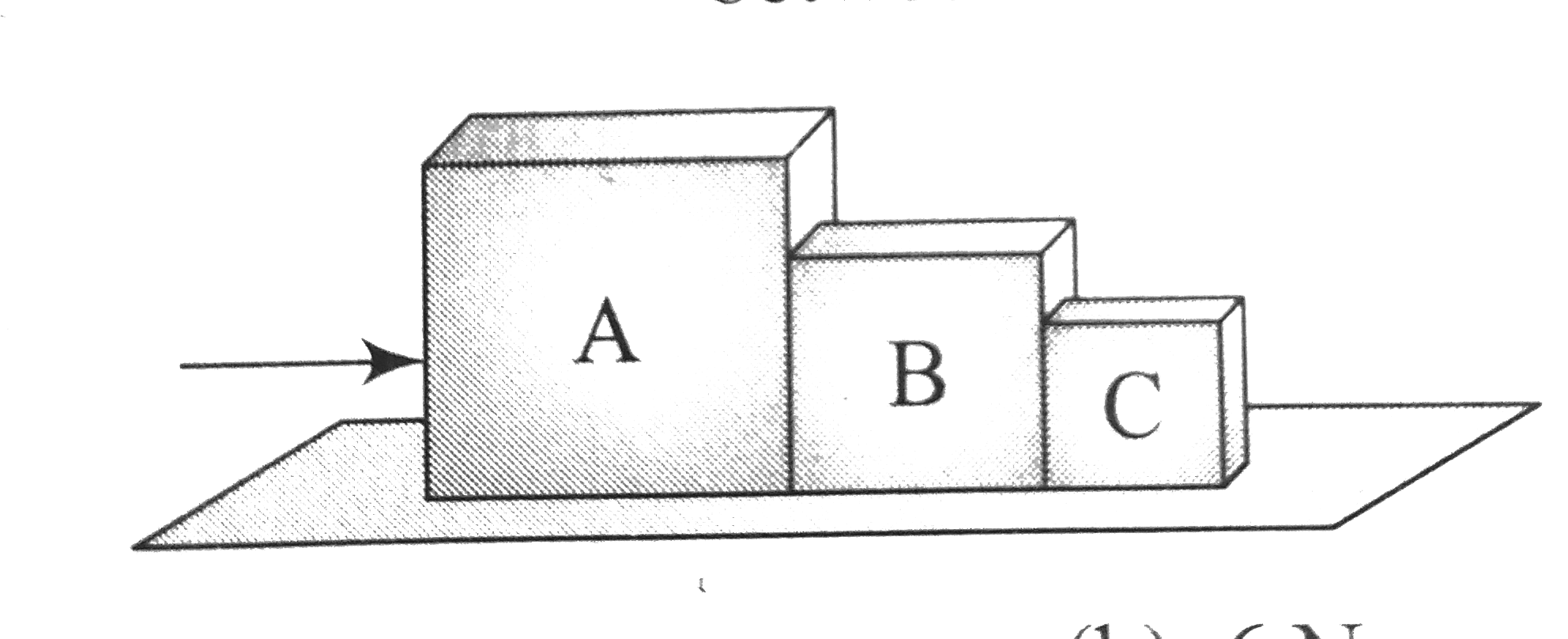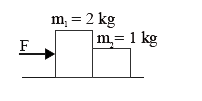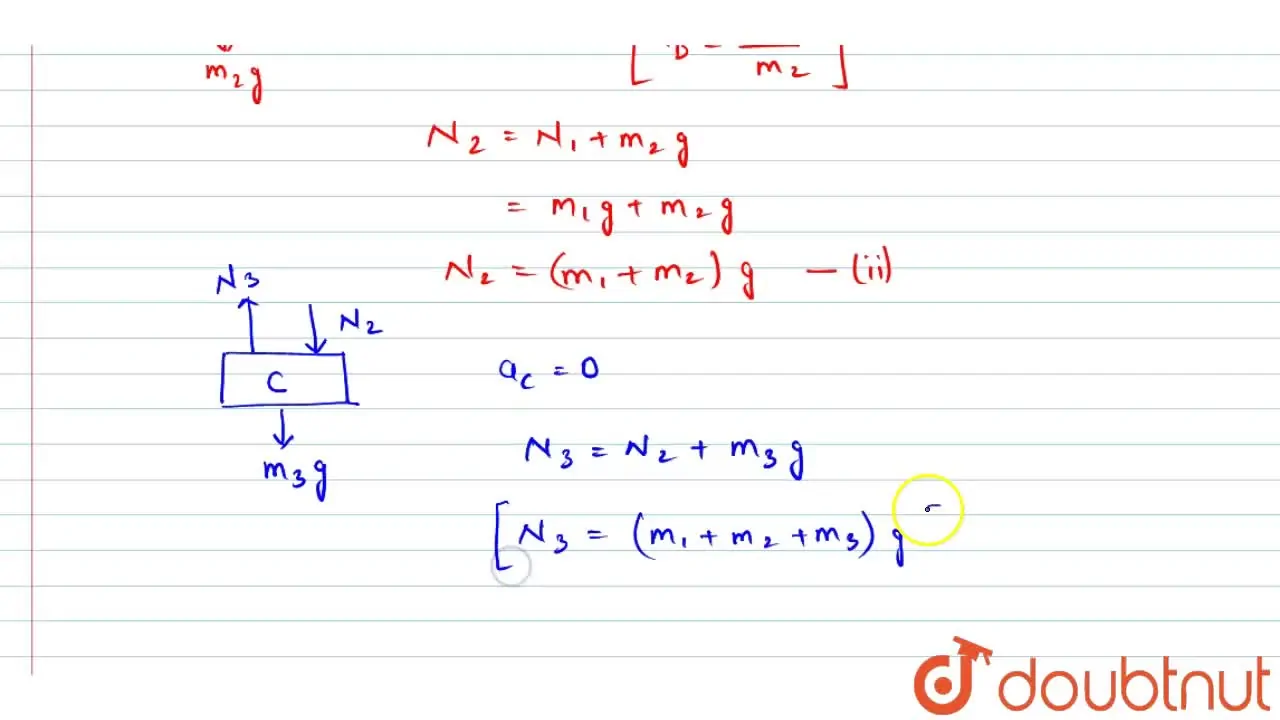Three block A,B,and C of mass m1,m2 and m3, respectively are resting one on top of the other as shown in fig. A horizontal force F is applied on block B. Assuming all the surfaces are frictionless, calculate (1) acceleration of block A, block B, and block C, (2) normal reactions between A and B, B and C, and between C and ground .

This system cannot be in equilibrium beacause in the horizontal direction, the system has a net external force F. As far as the vertical direction is concerned, all the force are internal action and reaction forces. These forces are equal and opposite, hence, they will cancel each other out

Body A : No external force is acting on it, hence, it will remain stationary in equilibrium. So acceleration at block A, aA=0 and
N1=m1g...(i) ltbr Body B: there is not external force acting on it vertically, hence, it will not have any acceletation in the vertical direction.
N2=N1+m2g=(m1+m2)g ...(ii)
However, there is one external force F action on it. so it will have some acceleration a in the horizontal direction such that
F+m2aB ...(iii)
which gives acceleration of block B , aB=Fm2
Body C and earth: Same comments as in the case of body A above.
N3=N2+m3g ...(iv)
and N3=(m1+m2+m3)g ...(v)
No external force acts on block C in the horizontal direction, Hence, aC is equal to 0.
Related Playlists
- BOOK - CENGAGE PHYSICS ENGLISHCHAPTER - NEWTON'S LAWS OF MOTION 1EXERCISE - Solved Examples11videos
NEWTON'S LAWS OF MOTION 1
- BOOK - CENGAGE PHYSICS ENGLISHCHAPTER - NEWTON'S LAWS OF MOTION 1EXERCISE - Exercise 6.111videos
NEWTON'S LAWS OF MOTION 1
- BOOK - CENGAGE PHYSICS ENGLISHCHAPTER - MISCELLANEOUS VOLUME 2EXERCISE - INTEGER_TYPE10videos
MISCELLANEOUS VOLUME 2
- BOOK - CENGAGE PHYSICS ENGLISHCHAPTER - NEWTON'S LAWS OF MOTION 2EXERCISE - Integer type1videos
NEWTON'S LAWS OF MOTION 2
Similar Questions
Two block of masses m1andm2 are placed side by side on a smooth horizontal surface as shown in fig. A horizontal force F is applied on the block .

(a) Find the acceleration of each block.
(b) Find the normal reaction between the two blocks.View SolutionThree blocks A , B and C of masses 4kg , 2kg and 1kg respectively are in contact on a frictionless surface, as shown. If a force of 14Nisappliedonthe4kgblock,thenthecontactforcebetweenAandB is.
 View Solution
View SolutionThree blocks A , B and C of masses 4kg , 2kg and 1kg respectively are in contact on a frictionless surface, as shown. If a force of 14Nisappliedonthe4kgblock,thenthecontactforcebetweenAandB is.
 View Solution
View SolutionA small block B of mass m2 is placed on another block A of mass m1 A constant horizontal force F is applied to the block A. All the surfaces are assumed to be frictionless. Find the acceleration of center of mass of the system
View SolutionTwo blocks of mass m1andm2 lie on smooth horizontal table in contact with each other as shown in figure

If a force F is applied to the mass m1 then the contact force between the block will beView SolutionBlocks are in contact on a frictionless table. A horizontal force F=3N is applied to one block as shown. The force exerted by the smaller block m2 on block m1 is :
 View Solution
View SolutionTwo blocks of masses M1andM2 are placed in contact with each other on a frictionless horizontal surface. If a force F is applied on the block of mass M1, what is the contact force between the two blocks?
View SolutionTwo block A and B of mass M & 3M are connected through a light string. One end of the string is connected to the blcok B and its other end is connected to a fixed point S as shown in fig. Now a force F is applied to block B. find the acceleration of block A & B.
 View Solution
View SolutionIn the figure shown all surface are smooth. Find
(a)acceleration of all the blocks,
(b) net force on 4kg and 10kg blocks and ,
( c) force acting between 4kg and 10kg blocks.
 View Solution
View SolutionTwo blocks A and B of masses 10 kg and 5 kg respectively are placed inside a cart which is moving horizontally with an acceleration of2ms2 as shown in the figure. If all the surfaces are smooth then the ratio of normal reaction between the block A and vertical surface of the cart and normal reaction between the blocks A and B is
View Solution


